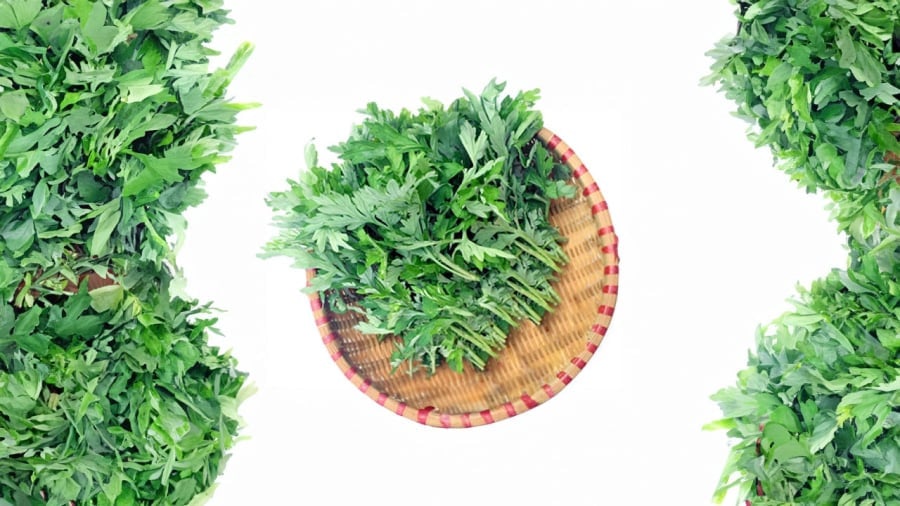Artemisia is a familiar herb, used both as a vegetable and as a medicine. In Vietnam, Artemisia appears in vegetable markets as a type of vegetable used for hot pot and soup. Artemisia also appears in traditional medicine stores as a famous Chinese medicine herb.
In traditional Chinese medicine, Artemisia is a warm medicinal herb with a bitter taste that enters the heart, liver, and kidney meridians. Artemisia can be combined with eggs to make Artemisia omelette, added to soup with chicken or carp to make nutritious soup, simmered with black-boned chicken and fertilized eggs…
Benefits of Artemisia
Artemisia stems and leaves contain essential oils ranging from 0.20 – 0.34% with main components being monoterpenes, dehydromatricaria ester, tetradecatrilin, tricosanol, aracholalcohol and sesquiterpenes… Thanks to these active ingredients, Artemisia helps relieve pain, promote blood circulation, and improve circulation. Artemisia also has the function of aiding digestion and diuresis. Artemisia is used to calm the mind, promote bile, have antibacterial properties, and stop bleeding… According to folk experience, eating Artemisia has the effect of treating irregular menstruation, urinating blood, preventing bloating, abdominal discomfort, diarrhea, and constipation…

Artemisia supports the digestive system: One of the main functions of Artemisia is to support digestion, helping to improve the digestive health from the liver, gallbladder, to the intestines. When eating Artemisia, it has a bile-promoting effect, thereby enhancing digestion and supporting liver function, helping digestion. Therefore, eating Artemisia also treats constipation and indigestion. You can clean Artemisia and simmer with carp to make Artemisia carp soup.
Regulates menstruation: Artemisia is a medicinal herb that helps treat amenorrhea, dysmenorrhea, and regulates menstruation. Artemisia treats women’s cold hands and feet. You can dry Artemisia, brew it like tea. Drinking Artemisia tea helps warm the uterus, improve women’s reproductive health.
Cold prevention, skin beauty: Artemisia leaves help enhance blood circulation, balance yin and yang in the body, prevent colds. Using Artemisia to soak feet helps clear blood vessels. You should use Artemisia water to wash your face.
Treats bone and joint pain: Artemisia helps relieve joint pain, especially in women after giving birth. How to use: Boil Artemisia leaves to make a bath, you can use 50 grams of dried Artemisia and a few slices of ginger to boil bathwater or soak your feet. Dried Artemisia has the effect of regulating blood circulation, warming blood vessels, relieving pain. Women after giving birth are prone to cold, so often using Artemisia to boil bathwater is beneficial.
Treats dandruff, reduces scalp itching, promotes good sleep: Artemisia has anti-inflammatory properties, so it can help treat itchy scalp. Washing hair with Artemisia water helps cleanse the scalp, treat dandruff and make hair beautiful. At first, you should wash with Artemisia water about 3 times/week. After the scalp is no longer itchy, you can wash 1-2 times/week. Persistently implementing this method, the hair will become more voluminous and dandruff will disappear. Washing your hair with Artemisia also helps improve relaxation of blood circulation, reduce headache and improve sleep.
Treats athlete’s foot, reduces edema: Artemisia leaves have antiseptic and anti-inflammatory effects. Consistently soaking your feet with Artemisia water can inhibit the growth and reproduction of bacteria on your feet, thereby preventing athlete’s foot and reducing edema.
Artemisia helps stop bleeding: Artemisia is often used to treat external wounds and vomiting with blood. The way to use it is to wash and mash Artemisia leaves and apply them to the skin.
Treats body weaknesses: Artemisia in folklore is known as a highly effective tonic herb. You can cook Artemisia with lotus seeds, red apples, and black-bone chicken, simmer thoroughly to make a high-nutrition dish that helps to unblock blood circulation, treat loss of appetite, bodily weakness in newly recovered patients and patients with long-term illnesses. Using carp to make Artemisia soup also helps improve nutrition, relieve fatigue, and bodily weakness.
Improves blood circulation, treats periorbital edema: For those who often have eye dizziness, poor blood circulation, difficult blood supply to the brain, dizziness, Artemisia omelette or Artemisia soup can be used to improve the condition.
Precautions for using Artemisia for safety
There are two types of Artemisia: white and purple, but white Artemisia is more commonly grown. You can use both types, but white Artemisia is usually easier to eat because it is less bitter. You should also be flexible in eating Artemisia, instead of frequently eating Artemisia omelettes, as eating too many eggs is not good for health. You can also use Artemisia to cook soup with minced meat, Artemisia soup with chicken bones, dip Artemisia in hotpot soup…
For brewed or boiled Artemisia, you should only use 3-5g of dried (9-15g of fresh) each time and use it in phases. When cured, you should take a break, avoid long-term continuous use.
Some people, such as kidney patients, hepatitis patients, pregnant women in the early months, and people with acute bowel disorders, should limit the use of Artemisia.































